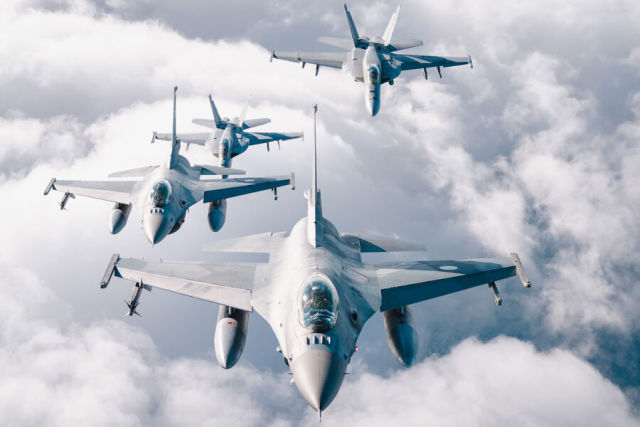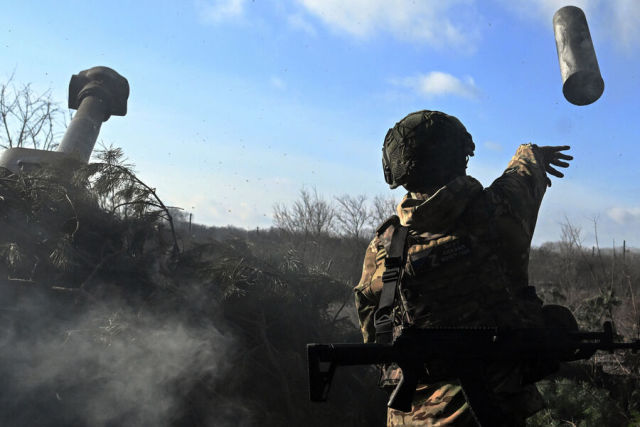Colonel Khodarenok: in 2024, the Russian Armed Forces will try to cut off Ukraine from the Black Sea
One of the most important operational and strategic results of the summer-autumn campaign of 2023 is the disruption of the offensive operation of the Armed Forces of Ukraine. How events will develop on the fronts in the first half of 2024, the military observer of Gazeta analyzed.En" Mikhail Khodarenok.
The unconditional success of the Russian Armed Forces in 2023 is the reflection of the widely publicized Ukrainian "counteroffensive". Despite significant supplies of weapons and equipment to the Armed Forces of Ukraine from the collective West, the Ukrainian army was able to make only minor progress in the Zaporozhye direction during the fighting, failing to overcome even the tactical defense zone of the Russian troops.
The APU had to pay a very high price for advancing several kilometers. The losses in personnel and equipment turned out to be more than significant, and the leadership of the Armed Forces of Ukraine had to abandon plans to continue further offensive actions. A completely natural question arises - how will the situation develop in the area of self-defense in the near future?
The transition of the Armed Forces of Ukraine to strategic defense
After the completion of an unsuccessful offensive operation for them in the summer-autumn campaign of 2023, the Armed Forces of Ukraine switched to strategic defense in order to repel a possible enemy offensive, defeat its troops, hold important areas and facilities in the defended territory, restore the situation in the most important areas and create conditions for new offensive operations.
In connection with the transition to strategic defense, the Armed Forces of Ukraine have begun to create a system of defensive lines, strengthen air defense and missile defense groups in the theater of military operations, and are engaged in the construction of operational engineering barriers.
There will certainly be a new wave of mobilization of 500 thousand reservists in Ukraine in the near future, the question here for the legislative and executive authorities is only in details, since there is simply no other way out for the leadership of the state and the Armed Forces of Ukraine in the current situation. The additional number will be used to replenish units and formations that suffered significant losses in the summer and autumn campaign, and to form strategic reserves.
Thus, the main task in the winter campaign of 2024 for the Armed Forces of Ukraine is to inflict the maximum possible losses of the Armed Forces of the Russian Federation in personnel, weapons and military equipment. Subsequently, with the creation of favorable conditions (mainly supplies from the West of necessary weapons and military equipment), it is possible for the Armed Forces of Ukraine to launch another counteroffensive.
In short, the fighting in the area of its own can drag on for many years. The European Union is currently preparing a backup plan to help Ukraine in the amount of up to €20 billion by increasing debt, which will circumvent the objections of Hungarian President Viktor Orban.
By the way, the position of the leaders of Hungary and Slovakia on the issue of assistance to Ukraine may lead (and in the very near future) to serious reformations within the European Union and NATO. Most likely, disagreements in the West in the very near future will lead to a reform of the governance scheme in both the North Atlantic Alliance and the European Union: either fateful decisions will begin to be made by a qualified majority, or individual countries will have the right to a decisive vote, while others will only have an advisory one. However, other options are possible.
After the end of the Christmas holidays of the US Congress, Washington will return to the issue of resuming financing for Ukraine. Most likely, this will happen in the second half of January 2024.
At the same time, the issue of providing financial assistance to Ukraine is not even as critical as direct supplies of weapons, military equipment and materiel. But this problem will also be solved by the collective West in the near future. Moreover, Japan and South Korea are fully involved in such events. Because neither Washington nor Brussels intend to allow a military defeat of Ukraine.
War in the air
In the near future, Norway, the Netherlands and Denmark will begin transferring multifunctional F-16 fighters to the Ukrainian Air Forces. The first group of Ukrainian pilots trained on the F-16 is already ready.

F-16 fighter jets
Image source: Global Look Press
Denmark has postponed the transfer of fighters to the AFU Air Force for several months. The Netherlands intends to send 18 combat vehicles to Ukraine. There is reason to believe that the pace of deliveries of multifunctional fighters to Kiev will only increase over time.
The aircraft were built mainly in the 1980s, but in the 2000s the machines underwent several stages of deep modernization and fully meet the requirements for conducting modern combat operations in the air.
The Air Forces of Ukraine (with the acquisition of long-range air-to-air missiles of the AIM-120 type) will have significantly more opportunities to conduct effective air battles with our Su-30 and Su-35, to strike targets deep behind the lines of our troops (F-16 are carriers of Storm Shadow and TAURUS KEPD missiles 350/150), the fight against electronic means of anti-aircraft missile forces using anti-radar missiles of the AGM-88 HARM type.
It is quite possible that the Norwegian F-16AM/BMs transferred to Ukraine will receive medium- and short-range Penguin Mk anti-ship missiles as aviation weapons.3 with a range of up to 55 km, developed by Kongsberg Defense & Aerospace. The mass of the missile's warhead reaches 130 kg. That is, a real hunt will be launched for all the large surface ships of the Black Sea Fleet.
Fighting on the Black Sea
A significant part of the Russian expert community has a more than critical attitude towards the restoration of the naval personnel of the Ukrainian Navy. At the same time, the capabilities of Kiev and its allies to recreate the naval power of the Ukrainian state are assessed by many experts as very real.
Most likely, the plans of the Ukrainian leadership do not intend to have large-displacement surface ships in the Navy (Ivan Mazepa-type frigates under construction in Turkey, after the end of the armed conflict, will most likely perform purely representative functions for the Ukrainian state).
Today, the Black Sea is being shot across and across by anti-ship missiles of various types, and there are not so many chances for a frigate-corvette class ship to survive in this situation. In addition, all ship repair facilities available to the State are also under possible enemy attacks. In short, a large ship has nowhere to hide if necessary, and in case of damage, there is nowhere to repair it. This is the reality of modern warfare on the Black Sea.
The supply of ships to Ukraine through the Dardanelles and Bosphorus Straits may encounter a ban on Turkey on the basis of the Montreux Convention on the passage of warships and vessels with military equipment.
However, Kiev can take advantage of the opportunities to supply marine equipment along the Rhine-Main-Danube river transport highway from Ulm (Germany) to the Black Sea through the Sulinsky Throat with access to the sea through the Sulinsky Canal. Ships of relatively small displacement can be transferred to the Navy along this route - small missile boats, minesweepers, patrol boats and even submarines of small displacement (for example, German Project 209).
And we must also prepare seriously for such a scenario.
The UAV factor
The scale of the combat use of unmanned aerial vehicles in the area of their own in the very near future will increase, and will increase many times. And today it is quite possible to talk about the dominance of UAVs over the battlefield. There is no doubt that in the near future, the military accounting specialty "UAV operator" will become as common in the military as the shooter of motorized rifle units (as you know, this is the primary military position of an ordinary serviceman).
Unmanned aerial vehicles attack individual soldiers during combat operations and even more so operate at night. It is at night that a change of units on the front line is carried out in the zone of the SVO, ammunition, food, and fuel are transported. And almost an artificial intelligence UAV is already on the way.
In terms of combating unmanned aerial vehicles, the importance of almost all electronic warfare equipment is significantly increasing. Today, the Russian army uses such complexes as Krasukha (of various modifications), Breakwater, Triton, and Lesochek during combat operations. To combat UAVs, portable electronic warfare systems are already being installed on individual samples of armored vehicles.
In general, once again we can say this - whoever wins the battle for the ether in this armed confrontation (and this means success in the fight against UAVs) will be able to advance.
What to expect from the Armed Forces of the Russian Federation
Of course, such plans can only be discussed in the form of assumptions and hypotheses. But, most likely, they look like this: after the capture of Avdiivka, the Russian army plans to enter the administrative borders of the LPR and the DPR. After that, there is reason to believe that the command of the Armed Forces of the Russian Federation will consider the issue of the final capture of the Kherson and Zaporizhia regions.
The main task in this case will probably be formulated as follows: to cut off Ukraine from the Black Sea.
As the main conclusion, we can say only one thing - the main battles and battles in the special military operation zone are still ahead.
The opinion of the author may not coincide with the position of the editorial board.
Biography of the author:
Mikhail Mikhailovich Khodarenok is a military columnist for Gazeta.Ru", retired colonel.
He graduated from the Minsk Higher Engineering Anti-Aircraft Missile School (1976), the Military Air Defense Command Academy (1986).
Commander of the S-75 anti-aircraft missile division (1980-1983).
Deputy commander of the anti-aircraft missile regiment (1986-1988).
Senior Officer of the General Staff of the Air Defense Forces (1988-1992).
Officer of the Main Operational Directorate of the General Staff (1992-2000).
Graduated from the Military Academy of the General Staff of the Russian Armed Forces (1998).
Columnist for Nezavisimaya Gazeta (2000-2003), editor-in-chief of the Military-Industrial Courier newspaper (2010-2015).
Mikhail Khodarenok








